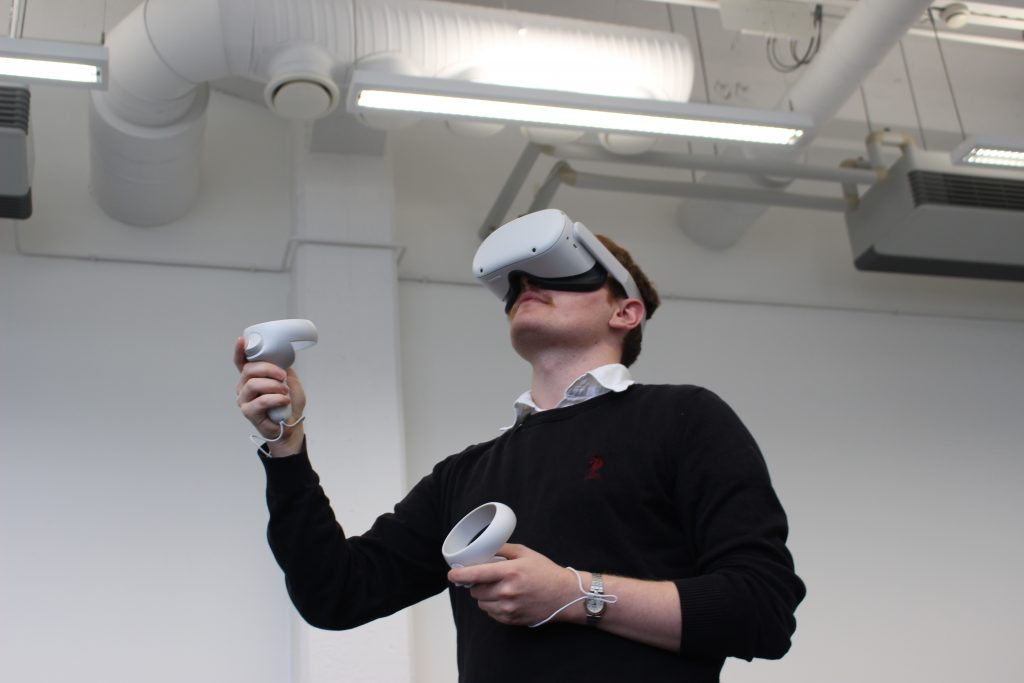
The Motion Sickness in Virtual Reality
Esseen tyyppi: Yksilöessee / 2 esseepistettä.
The first time you try on the virtual reality headsets, it almost feels like you are entering another world which you have not known before. Since this new environment is unfamiliar to the human brain, the hormones that are being activated in your body trick our brain into thinking that we are in an environment where we haven’t been before, even though the world that surrounds us is fully digital and does not exist in actual real life. We can almost resemble it into being in an imaginary world where you dream at night, but it is also real. You are in a dream where you control what’s happening around you without affecting your actual reality.
The world that surrounds you is fully 3D, just like how you vision the real world. Every object has a depth and is affected by each other, and you are a part of this existence. What makes this world as realistic as in the real world is the immersvieness of the environment that is being created. An article called Making Reality Virtual: How VR “Tricks” Your Brain a good example is given as: “For instance, we can see a dog running across the room, hear her bark, and feel her fur brush against our skin—these are sensations that we come to understand and perceive as experiences. The sensations all come together through perception to give us the experience of the dog. It is this interplay of sensation (using vision, hearing, etc.) and perception (our brain’s interpretation of this information) that creates our experience of reality.” (Penn & Hout 2018). With Virtual Reality, all of our senses are taken into consideration and this is what the UI ( user interface ) and UX ( user experience ) developers have been working on to make the experience as immersive as possible. A great extension for the example with the previous article is that, in real world you hear the bark of a dog not from every angle, but from the angle where the dog is positioned to you. So if the dog is barking and it is on your back, you only hear the dog in a way that is it on your back. In virtual reality, developers design the immersive sound experience in the same way. If a dog barks in virtual reality, you hear it from the same angle as where it is positioned to you, which makes you think that the dog is barking behind you, even if you can not see the dog physically since it is out of your vision, however, you know that there is a dog behind you in the virtual world because the virtual reality activated your senses to hear the dog behind you.
The immersive environment can be scaled from the point of view of an ant, or from the point of view of an satellite in space. No matter what the scale is, your vision is in the frames of the VR headsets, and it is all about the perspective you look at into the world and how big it has been created. We can sum it as the more what you see is immersive, the more your brain starts to think that what you encounter is real.
An virtual reality game called Echo is a great example of the immersive environment and how it affects the brain to think that the surroundings feel real. In the game you are put into a zero gravity environment as a robot. In this case the immersive environment is gravity free, which allows you to float in the air and trick the brain as in you are actually floating in the air, when in reality you are either standing up or just sitting down in the chair. This false alert that is being transformed into your brain can cause some illusions that you are being triggered by some emotions which floating in the air might bring to you when you are expecting to be triggered by the emotions which sitting in a chair might bring. Since the expectations might not match the reality you are in, it can make the brain confused.
As new technologies are being presented, they also bring new terminologies with them on their way. One of the most common terms that come as a result of working in virtual reality is the motion sickness after being exposed to the technology for excessive hours. An article called Motion Sickness in VR: Why it happens and how to minimise it explains the motion sickness as: “VR motion sickness happens when your brain receives conflicting signals about movement in the environment around you, and your body’s relation to it. In VR, this essentially means that if you are standing still and the virtual environment around you is moving, you disturb the brain’s equilibrium and you start to feel nauseous.” (Thompson 2020)
Another reason why brain feels the motion sickness is also caused by the limitations of the gadget you experience virtual reality with, which are most likely to be the headsets. Since we experience the real world with our eyes without any blocks on the sides, we do not have any blocks from the sides, however, In virtual reality headsets your vision is slightly covered with the headsets from the sides which causes you to see the immersive 3D world in a slightly clustered way than you see the actual real world. Since the immersive 3D environment is looked at with a different point of view and it does not match the eyes’ everyday experienced, it causes motion sickness to the person who is trying on the virtual reality headsets. An article called Motion Sickness in VR: Why it happens and how to minimise it gives an example of how the eye movement affects the motion sickness as: “If the virtual environment moves differently to what the eye expects, there’s a conflict in what the brain expects the eye to see and what it actually sees. As such, the eyes must move differently to how they normally do to stablise the image in VR on the retina – and it is this new movement that influences motion sickness.” (Thompson 2020)
The headsets have the battery life of roughly 3 hours which might be a good thing for the user to reduce the risk of having the motion sickness, since you can not use it more than 3 hours at a time. It is important to limit the time you spend on virtual reality and do not lose touch with the real world in the meanwhile to avoid motion sickness. The other 3 hours which it takes to charge the glasses can be used by the owner of the headsets to get used to the real vision experience of the real world and get back to reality.
Thompson, S. 2022. Motion Sickness in VR: Why it happens and how to minimise it. Read on 09.10.2022. Link: https://virtualspeech.com/blog/motion-sickness-vr
Penn R. A. & Hout M. C. 2018. Making Reality Virtual: How VR “Tricks” Your Brain. Read on 09.10.2022. Link: https://kids.frontiersin.org/articles/10.3389/frym.2018.00062



